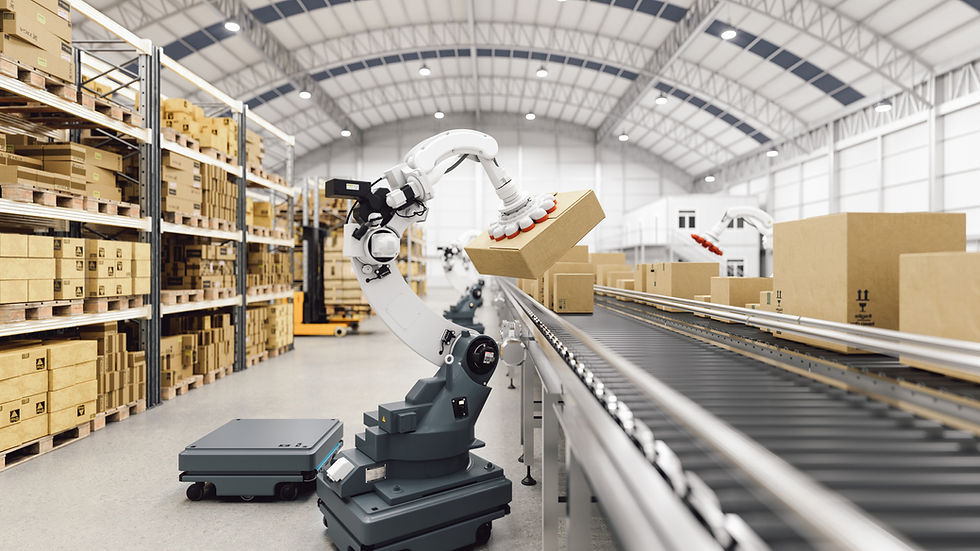Automation-Ready Building Retrofits: A Smart Investment for the Future
- Karl Issara Roarty

- May 20
- 4 min read
In our previous post on aging university infrastructure, we explored how campuses are beginning to modernize their operations through smarter, data-driven maintenance strategies. That sparked a broader question: What other sectors are facing similar infrastructure challenges, and how are they addressing them?

Industrial and commercial facilities are front and center in this conversation. Many of these buildings—whether manufacturing plants, distribution centers, office parks, or multi-use complexes—were built 30, 40, even 60 years ago, long before automation, digital sensors, or cloud-based platforms were even imagined. Today, operators are under immense pressure to adapt these legacy spaces for a digital future, but without sacrificing uptime or efficiency. The solution? Retrofitting existing buildings with automation-ready infrastructure that enables predictive maintenance, smarter asset tracking, and scalable digital transformation.
The Cost of Staying Analog
Outdated facilities are expensive to run and harder to maintain. HVAC, lighting, plumbing, and electrical systems are often near the end of their useful lives, and many buildings lack the structural flexibility to accommodate modern systems. According to a 2024 CBRE report, over 70% of U.S. industrial facilities are more than 20 years old, and nearly 40% lack the digital infrastructure necessary to support even basic IoT deployment.
These inefficiencies come at a cost:
Unplanned downtime can cost manufacturers $260,000 per hour, according to Deloitte.
Energy loss from outdated systems contributes to 20–30% in excess operating costs in commercial buildings.
Labor shortages have forced teams to do more with fewer skilled maintenance staff, exacerbating the maintenance backlog.
In an era of real-time logistics, hybrid work models, and smart tenant expectations, the analog status quo is becoming untenable.
What “Automation-Ready” Looks Like in Practice
Retrofitting for automation doesn’t mean gutting a building—it means enabling it. The most successful retrofits focus on incremental infrastructure investments that enable scalable technology adoption:
Digital backbone upgrades such as fiber-optic cabling, 5G networks, or industrial Wi-Fi to support real-time monitoring.
High-capacity power panels and smart meters to support robotic systems and energy analytics.
IoT sensors for condition-based monitoring of HVAC, lighting, fire systems, and critical assets.
CMMS integration to tie physical systems to a centralized digital dashboard that can automate work orders, track maintenance KPIs, and generate asset performance reports.
Facilities equipped with modern CMMS platforms and IoT have shown maintenance cost reductions of 15–25%, and equipment uptime increases of up to 35%, per a 2023 McKinsey study. automation-ready building retrofits
Where the Sector Stands Today
While many industrial and commercial operators recognize the value of digital transformation, actual adoption varies widely by region, industry type, and facility age. A 2023 survey by Verdantix revealed that:
Only 38% of industrial firms have adopted full-scale digital maintenance platforms.
52% still rely on spreadsheets or fragmented systems for facilities management.
However, 74% of decision-makers plan to increase spending on smart building and automation infrastructure by 2026.
Budgets are starting to reflect that shift. CBRE forecasts that facilities modernization spending will grow 9.8% year-over-year, with a significant portion earmarked for technology upgrades—especially in warehousing, logistics, and data center operations.
automation-ready building retrofits
Despite these gaps, there is clear momentum. IDC forecasts that global spending on intelligent building technology will reach $127 billion by 2027, with retrofits driving the majority of that growth.

The Cost of Staying Analog—and the Case for Smart Maintenance Transformation
This is precisely where a platform like Alpaca Technology makes a difference. Unlike traditional CMMS tools that often require manual inputs and rigid workflows, Alpaca is purpose-built for operators managing complex industrial and commercial facilities. It bridges the gap between analog systems and intelligent infrastructure—enabling teams to connect, visualize, and act on maintenance data in real time.
For field teams, Alpaca’s mobile-first approach ensures that technicians can access and update work orders from anywhere—even in low-connectivity environments—streamlining coordination without sacrificing speed or accuracy. Meanwhile, operations managers gain a clearer picture of system performance across properties, with customizable reports that support smarter budgeting, workforce planning, and vendor accountability. By implementing new or integrating with existing IoT sensors and digital meters, Alpaca provides a live window into the health of critical assets—giving operators the ability to detect inefficiencies and anticipate failures before they occur. The platform uses AI to analyze performance trends, recommend preventive actions, and prioritize maintenance tasks based on real-world conditions, not guesswork.
And for those just beginning their digital transformation journey, Alpaca is designed to scale. Clients can start small—with one facility, one asset type, or one maintenance crew—and expand as their infrastructure and confidence grow. This modular approach allows organizations to adopt smart maintenance strategies without overwhelming their existing systems or teams.
automation-ready building retrofits
Looking Ahead
As we saw with universities, retrofitting aging buildings isn’t just a facilities issue—it’s a strategic move. In the industrial and commercial world, retrofitting for automation means protecting uptime, reducing operational risk, and preparing for a more connected, data-driven future.
The physical shell of the building may be old—but with the right infrastructure upgrades and a smart maintenance platform like Alpaca Technology, what’s inside can be as intelligent and agile as any new build. automation-ready building retrofits


Comments